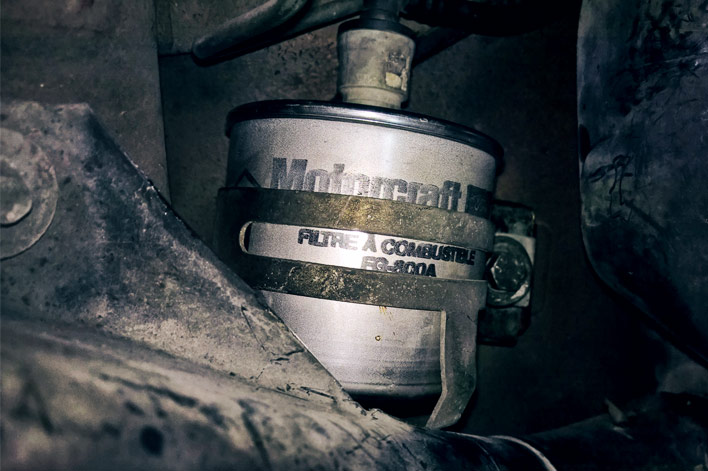This Is the Real Cost of a Fuel Filter Replacement
18th Jan 2017

Regardless of your level of understanding, just about everyone is aware that the engine is the most essential part of an automobile. Everything that accompanies the engine inside the engine compartment of a car is there to protect or improve the performance of the engine. That includes the fuel filter.
If you own a car there will no doubt be times when you will have to replace the fuel filter. If you don’t, then it is possible that the engine can get damaged. When that moment comes, then you will be concerned with the fuel filter replacement cost.
Before we get into more detail about fuel filter replacement cost, we need to understand what a fuel filter is, what it does, how it works and how you will know that it needs to be replaced.
What Is A Fuel Filter?
Commonly placed within the fuel line of the car, a fuel filter is designed to capture and hold dirt, dust, rust particles and other contaminants that may be flowing in the fuel before the fuel reaches the engine. If these contaminants are not removed, then it is possible that the fuel system as well as the engine could be damaged.
Fuel filters are available in a wide assortment of shapes and sizes. Most are constructed of special heat-resistant paper mesh compressed in a metal or plastic cover.
There are three types of fuel filters –- primary, secondary, and pre-tank.
A primary fuel filter is attached between the fuel tank and the feed lines to the carburetor or fuel injectors and includes a number of characteristics other than filtering the fuel including the ability to separate water from the fuel. It is commonly located after the fuel pump. Two types are available –- a standalone or a combination filter and water separator. This filter is ideal for people who live in regions where the temperature can change quickly or is very humid and can help prevent water from appearing in the fuel line causing problems with fuel-line freeze up.
A secondary fuel filter commonly appears very close to or in the intake section of the carburetor system or near the fuel injection system or hosted in a canister that is installed to the exterior of a diesel engine. While many mechanics claim that the filter can last the lifetime of the car, most suggest that you still replace it every 30,000 miles whether it is needed or not.
Pre-tank filters are made of a funnel-shaped metal or plastic mesh and are placed where fuel is poured into the vehicle.
Fuel filters are not manufactured as a one size fits all. They are different depending on the type of fuel delivery system they are integrated to. For example, a carbureted engine features a vacuum that pulls fuel into the engine. It is a low-pressure metal or plastic system that includes an inlet tube. The fuel filter that integrates into this system typically is made of metal or plastic. The inlet tube enters the filter on one end and another tube comes out the other. The filter is attached to the tubes with circular clamps, a nut or washer.
An electronic fuel injection delivery system relies on injectors that squirt fuel into each of the engine’s cylinders. In this case, the fuel filter has threaded fittings on each end and screws into the fuel lines on either side.
The fuel filters have to be installed so that the flow of the fuel is going in the proper direction –- into and then out of the filter. Most filters are labeled with one side marked “in” and the other side marked “out.”
Mechanics suggest that you replace the filter once a year, but no later than every two years. However, if your car experiences a reduction in miles per gallon or lethargic engine performance, then consider replacing the filter.
If the fuel filter is not changed, then it can get clogged with dirt, dust, rust and other contaminants adversely affecting your vehicle’s performance. In fact, if the fuel filter is clogged with large or abundance of debris, then gasoline flow through the fuel system could stop preventing the car from starting.
How to Choose a Fuel Filter
Use these principles when selecting a replacement fuel filter.
✔ Choose a filter that is designed specifically for the year, make, model and engine size of your car.
✔ Choose a filter that is the same size or a little bit larger than the filter being replaced.
✔ If you have experienced problems with dirt or debris buildup or fuel-line freeze up, select a filter with a vacuum gauge, which will indicate when the flow of fuel is beginning to be restricted so you can replace quickly.
Tools Needed to Replace a Fuel Filter
Changing the fuel filter is not a difficult task. It is possible to do it yourself. The tools you will need to perform the work include:
- Wrenches
- Sockets
- Screwdriver
- Pliers
Of course, how specific the tool depends on how the fuel filter is connected to the fuel line.
For example, if the fuel filter is threaded, then you can use an open-ended wrench or ratchet and socket. If the filter is attached with clips, a pair of pliers will suffice.
Some car manufacturers including General Motors, Ford and Mazda have attached the factory fuel filters using spring-loaded locks. To deal with this, you will need a quick disconnect tool.
Inspect how the filter has been connected before starting the work. If it appears complicated, then consult with the car’s manufacturer.
Fuel Filter Replacement Cost Comparison
The popular automotive chain stores that sell fuel filters and also install them include Midas, Mr. Tire, and Pep Boys.
Here are fuel filter replacement costs for these outlets.
Midas: Parts & Labor $64-$188
Mr. Tire: Parts & Labor $71-$213
Pep Boys: Parts & Labor $79-$199
Popular stores that offer a wide assortment of fuel filters not including installation include:
Walmart: Parts $6-$45
Amazon: Parts $8-$110
Autozone: Parts $1.99-217.99
Saving Money on Fuel Filter Replacement
The greatest savings can be achieved if you perform the installation yourself. If you are a regular do it yourselfer, then you probably already have the tools you will need on hand to perform the job. You can often save on fuel filter replacement cost researching and buying from online stores. You can also save money by selecting aftermarket filters rather than OEM. Shop with an eye on finding the best deals.
If you have regular maintenance performed at a neighborhood car repair and service shop, then schedule replacement of the fuel filter when you have annual service performed. If you regularly go to a dealership to have your car maintained, choose one of these visits to replace the filter.
Finally, simply shop around in your area for the best deals.



